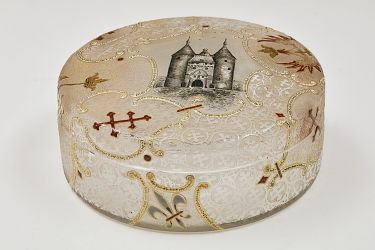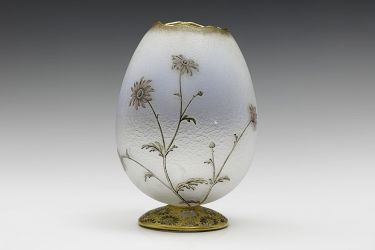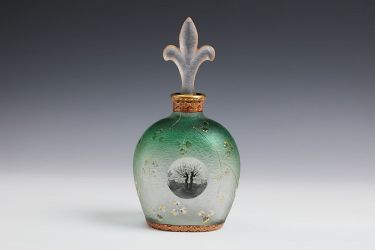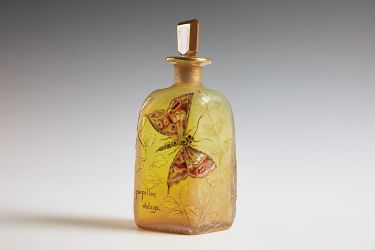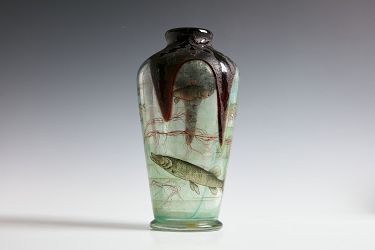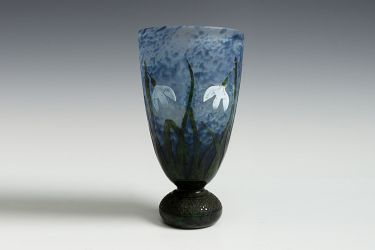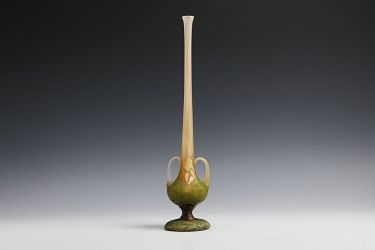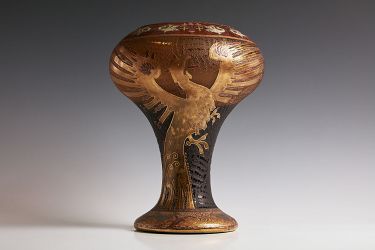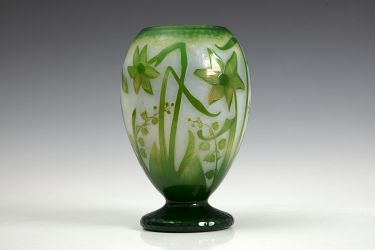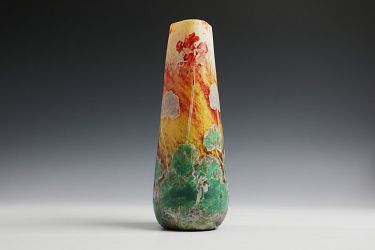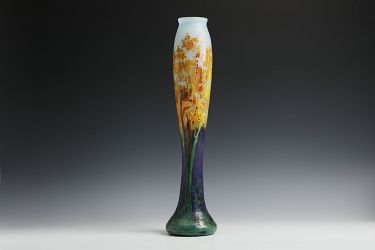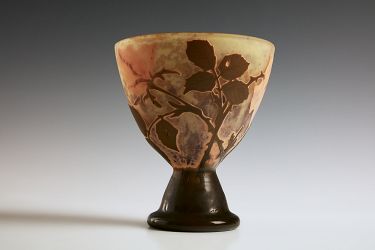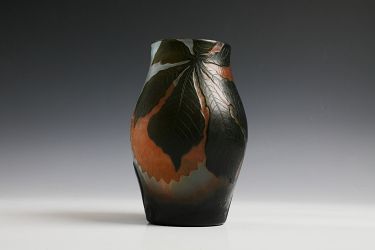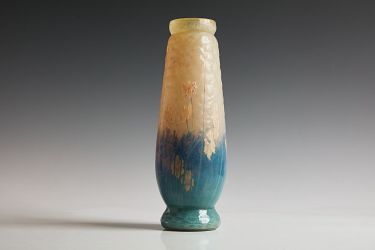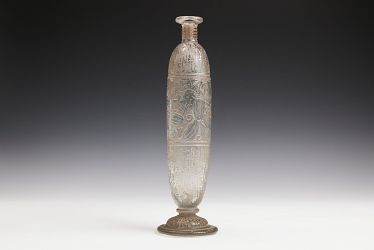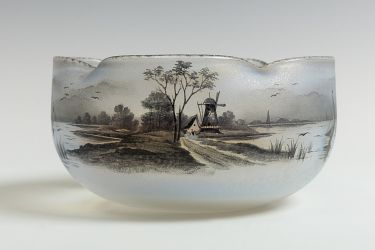Daum Frères
Family glasswork
Jean-Louis Auguste Daum (Bitche, Lorraine, 1853 - Nancy, 01.04.1909)
Jean Antonin Daum (Bitche, Lorraine, 30.10.1864 - Nancy, 28.03.1930)
Timeline
- 1878 Jean Daum became the owner of the St Catherine glassworks and renamed it “Nancy Glass”
- 1885 After the death of Jean Daum, his son Auguste Daum took over the glassworks
- 1887 Antonin Daum, the younger brother of Auguste, took over the artistic direction of the company
- 1891 Art workshops at the Nancy glassworks were organized at the factory and the company was named Daum Frères & Cie, Verreries de Nancy
- 1893 Chicago World's Fair, the first attempt to introduce the company's own glass outside Europe was made
- 1894 Exhibition of decorative-applied and industrial art of Lorraine in Nancy: glass by Daum company got high marks; Auguste Daum was awarded the Legion of Honour
- 1897 Grand Prix at the Brussels International Exposition
- 1900 Grand Prix at the Exposition Universelle of 1900, the leading artisans of the company were honored with silver and bronze medals
- 1880s Search for personal style
- 1904 Antonin Daum became the President of the École de Nancy after the death of Emile daum
- 1909 Auguste Daum died, the management of the firm passed to his sons
- 1925 At the International Exhibition of Modern Decorative and Industrial Arts, the Daum company demonstrated glass in the Art Deco style
- 1936 The company closure due to economic crisis and social contradictions
- Late 1940s The company business resumption
Brief biography and creative work
The flowering of French art glass in the second half of the 19th - early 20th centuries occurred due to the interaction of individual artistic vision and industrial production of high-quality serial items. An example of such a synthesis is the company Daum, which produces glass to this day.
For a long time its activity was perceived solely as following the principles of Emile daum, hence its own development of new techniques and creative searches were realized within its production. For almost a hundred years the company was run by members of the same family, and the prominent representatives of the Art Nouveau style were working in it: Jacques Grüber, Henri Bergé, etc.
The establishment of the company is connected with the name of Jean Daum, a notary, the Mayor’s assistant and respected citizen of the town of Bitche on the border between Alsace and Lorraine. After the end of the Franco-Prussian War, Jean Daum refused to accept Prussian citizenship, thus in 1876, he settled in Nancy with his family. In the new place Jean Daum invested in the development of la verrerie Sainte-Catherine de Nancy, founded in 1875. The business was doing poorly, and in 1878, Daum bought the factory and became its sole proprietor. He renamed the enterprise “Verreries de Nancy” and went into the watch glass and tableware business.
Soon Auguste Daum, Jean's eldest son, a lawyer by training, joined the work to solve organizational issues of production. He took over the company in 1885, after his father's death. Two years later, in 1887, he was joined by his younger brother Antonin Daum, who had graduated from the École centrale des arts et manufactures de Paris. Antonin was responsible for the creative part of production and between 1889-1891, he was engaged in organizing an art department in the factory to update the work process and range of products.
The need for transformation became apparent after the triumphant presentation of Emile daum's products at the Exposition Universelle of 1889. This is how the Atelliers d'Arts a la Verrerie de Nancy came into being, including workshops for glass blowing, grinding, carving, etching, painting and gilding, and the firm was renamed Daum Frères & Cie, Verreries de Nancy.
Customary forms of transparent glass in the Historicism style, which met the conventional preferences of the French bourgeoisie were the main type of products. The assortment also included transparent tinted glass of various hues. In addition to tableware, the firm produced perfume bottles, bonbonnières, soli-flore (a single flower) vases and other items. The surface of the items was decorated with emblems, heraldic motifs, Lorraine crosses, the Rococo style pastoral scenes and antique patterns made in enamel and gold painting. Landscape theme in the decoration of products became the embodiment of love for the native land and a symbol of its inhabitants' resilience on the wave of patriotism after the war of 1871. Views of Lorraine, images of the countryside and local landscapes remained in demand for a long time and remained in the company's range until the 1910s Views of Lorraine, images of the countryside and local landscapes remained in demand for a long time and were in the company's range until the 1910s.
The Daum brothers saw the company further development in training craftsmen and involvement of artists to work with glass. So, shortly after the opening of an art workshop at the factory, they organized their own two-year school for training glass designers, engravers and patternmakers. As part of the same strategy, Jacques Grüber, a professional artist and future stained glass artisan, was invited to collaborate in 1894. He created glass drawings for the Daum Frères enterprise and made sketches for the furniture of Louis Majorelle as well. Henri Bergé, who painted, sculpted and decorated porcelain and glassware, joined the company along with Grüber. He created models for the company products that were diverse in form and decoration, but did not require complex technological implementation and guaranteed commercial success of the company. Floral motifs prevailed in the designs by Bergé.
In the 1890s, work with tinted glass became a priority. Inspired by the success of E. Galle, the Daum Frères enterprise started producing multilayered tinted glass, the surface of which was treated with chisel or etched (la gravure a l'acide). Small-series production started in the same period. Plants and animals dominated in decoration that characterized Lorraine artists of the period and the Art Nouveau style. The Daum enterprise emphasized the figurative and decorative character of each flower and animal, while the items by Émile Gallé were characterized by deep symbolic content.
The last years of the 19th century were marked by high productivity of the "Atelliers d'Arts a la Verrerie de Nancy", where new artistic techniques were developed and introduced into mass production. In 1894, the martele technique was introduced: the surface of glass was tapped with a hammer or a special cutter, resulting in small dimples that imitated the surface of a forged product. In 1899, the Daum Company patented the intercalarie technique. While creating multilayered glass, a pictorial or graphic image was placed between a product layers that gave the effect of multidimensional landscape and increased the depth of the perspective.
The first attempt to gain widespread recognition was made in 1893, at the International Exposition in Chicago, where the Daum frères manufacture displayed out-of-competition products of the firm. In 1894, their glassware was highly appreciated at the Exhibition of decorative-applied and industrial art of Lorraine in their native Nancy. The triumph occurred at the Brussels International Exposition in 1897: the Daum frères manufactory was awarded the first in its history Grand Prix. The Exposition Universelle of 1900 in Paris also brought the Grand Prix to the firm and silver and bronze medals to the leading craftsmen.
Auguste Daum died in 1909. His sons Jean, Henri and Paul took over the management of the company. Antonin Daum was responsible for the artistic part of the company until his death in 1930. During the First World War the company operation was suspended, many workers went to the front, Jean Daum died on the battlefield in 1916. In the early post-war years, the company continued to produce the Art Nouveau style items based on the old models, but Paul Daum, who headed the company, sensed the change of the society aesthetic tastes and demands in the new period. Therefore, at the International Exhibition of Modern Decorative and Industrial Arts in Paris in 1925, which marked the emergence of the Art Deco style, the Daum Company demonstrated items created in the new aesthetics. The lowing floral ornamentation of the Art Nouveau style was replaced by the patterns strict geometry, enamel painting lost popularity, preference was given to glass monumental forms with smooth surface, in bright, saturated colors.
Today, the Daum Company is not the Daum family property. Nevertheless, the company still produces glassware, has a wide range of products, regularly cooperates with prominent designers and artists, remains one of the important players in the global glass industry.


